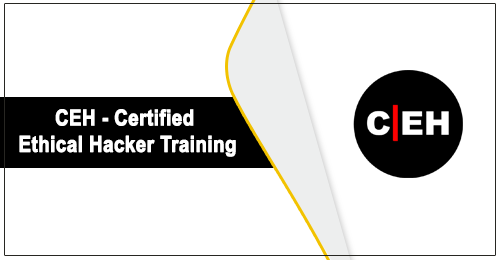CEH (V10)- Certified Ethical Hacker

Module 01- Introduction to Ethical Hacking
- 1 Demo of Aspen and iLabs
- 2 Internet is Integral Part of Business and Personal Life - What Happens Online in 60 Seconds
- 3 Essential Terminology
- 4 Elements of Information Security
- 5 The Security, Functionality, and Usability Triangle
- 1 Motives, Goals, and Objectives of Information Security Attacks
- 2 Top Information Security Attack Vectors
- 3 Information Security Threat Categories
- 4 Types of Attacks on a System
- 5 Information Warfare
- 1 What is Hacking
- 2 Who is a Hacker?
- 3 Hacker Classes
- 4 Hacking Phases
- 1 What is Ethical Hacking?
- 2 Why Ethical Hacking is Necessary
- 3 Scope and Limitations of Ethical Hacking
- 4 Skills of an Ethical Hacker
- 1 Information Assurance (IA)
- 2 Information Security Management Program
- 4 Enterprise Information Security Architecture (EISA)
- 5 Network Security Zoning
- 6 Defense in Depth
- 7 Information Security Policies
- 8 Physical Security
- 10 What is Risk?
- 11 Threat Modeling
- 12 Incident Management
- 13 Security Incident and Event Management (SIEM)
- 14 User Behavior Analytics (UBA)
- 15 Network Security Controls
- 16 Identity and Access Management (IAM)
- 17 Data Leakage
- 18 Data Backup
- 19 Data Recovery
- 20 Role of AI/ML in Cyber Security
- 1 Penetration Testing
- 2 Why Penetration Testing
- 3 Comparing Security Audit, Vulnerability Assessment, and Penetration Testing
- 4 Blue Teaming/Red Teaming
- 5 Types of Penetration Testing
- 6 Phases of Penetration Testing
- 7 Security Testing Methodology
- 1 Payment Card Industry Data Security Standard (PCI-DSS)
- 2 ISO/IEC 27001:2013
- 3 Health Insurance Portability and Accountability Act (HIPAA)
- 4 Sarbanes Oxley Act (SOX)
- 5 The Digital Millennium Copyright Act (DMCA)
- 6 Federal Information Security Management Act (FISMA)
- 7 Cyber Law in Different Countries
Module 02- Footprinting and Reconnaissance
- 1 What is Footprinting?
- 2 Objectives of Footprinting
1 Footprinting through Search Engines
2 Footprinting using Advanced Google Hacking Techniques
3 Information Gathering Using Google Advanced Search and Image Search
4 Google Hacking Database
5 VoIP and VPN Footprinting through Google Hacking Database
1 Finding Company’s Top-level Domains (TLDs) and Sub-domains
2 Finding the Geographical Location of the Target
3 People Search on Social Networking Sites and People Search Services
4 Gathering Information from LinkedIn
5 Gather Information from Financial Services
6 Footprinting through Job Sites
7 Monitoring Target Using Alerts
8 Information Gathering Using Groups, Forums, and Blogs
9 Determining the Operating System
10 VoIP and VPN Footprinting through SHODAN
- Collecting Information through Social Engineering on Social Networking Sites
1 Website Footprinting
2 Website Footprinting using Web Spiders
3 Mirroring Entire Website
4 Extracting Website Information from https://archive.org
5 Extracting Metadata of Public Documents
6 Monitoring Web Pages for Updates and Changes
1 Tracking Email Communications
2 Collecting Information from Email Header
3 Email Tracking Tools
1 Competitive Intelligence Gathering
2 Competitive Intelligence - When Did this Company Begin? How Did it Develop?
3 Competitive Intelligence - What Are the Company's Plans?
4 Competitive Intelligence - What Expert Opinions Say About the Company
5 Monitoring Website Traffic of Target Company
6 Tracking Online Reputation of the Target
1 Whois Lookup
2 Whois Lookup Result Analysis
3 Whois Lookup Tools
4 Finding IP Geolocation Information
1 Extracting DNS Information
2 DNS Interrogation Tools
1 Locate the Network Range
2 Traceroute
3 Traceroute
4 Traceroute Tools
1 Footprinting through Social Engineering
2 Collect Information Using Eavesdropping, Shoulder Surfing, and Dumpster Diving
1 Maltego
2 Recon-ng
3 FOCA
4 Recon-Dog
5 OSRFramework
6 Additional Footprinting Tools
1 Footprinting Countermeasures
1 Footprinting Pen Testing
2 Footprinting Pen Testing Report Templates
Module 03- Scanning Networks
1 Overview of Network Scanning
2 TCP Communication Flags
3 TCP/IP Communication
4 Creating Custom Packet Using TCP Flags
5 Scanning in IPv6 Networks
1 Nmap
2 Hping2 / Hping3
3 Scanning Tools
4 Scanning Tools for Mobile
1 IDS/Firewall Evasion Techniques
1 Banner Grabbing
2 How to Identify Target System OS
3 Banner Grabbing Countermeasures
1 Draw Network Diagrams
2 Network Discovery and Mapping Tools
3 Network Discovery Tools for Mobile
1 Scanning Pen Testing





